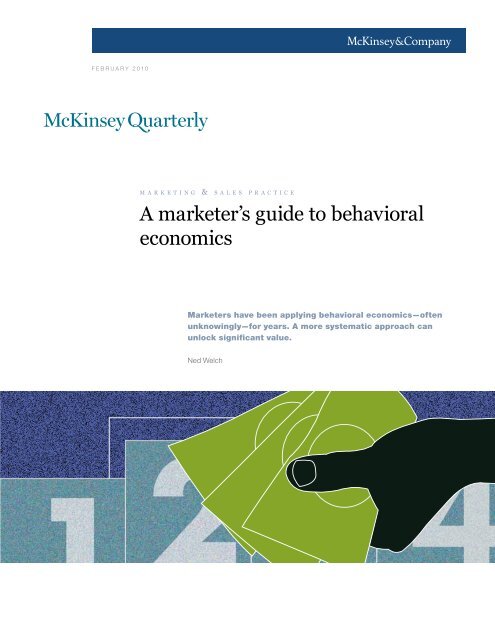Marketing Behavior - A marketer's guide to behavioral economics
Marketing Behavior - A marketer's guide to behavioral economics
Marketing Behavior - A marketer's guide to behavioral economics
You also want an ePaper? Increase the reach of your titles
YUMPU automatically turns print PDFs into web optimized ePapers that Google loves.
Crawford626 Step-Au<strong>to</strong>dock TProduktdatenblattUrheberrecht undHaftungsausschlussAuch wenn der Inhalt dieser Dokumentation mit größtmöglicher Sorgfalt zusammengestellt wurde, haftet ASSA ABLOY EntranceSystems nicht für Schäden, die auf Fehler oder Auslassungen in dieser Dokumentation zurückzuführen sind. Wir behalten unsaußerdem das Recht vor, ohne vorherige Benachrichtigung technische Veränderungen/Ersetzungen vorzunehmen.Die Inhalte dieser Dokumentation stellen keine Grundlage für Rechte irgendeiner Art dar.Farbhinweis: Aufgrund unterschiedlicher Druckverfahren kann es zu Farbabweichungen kommen.Die Bezeichnungen ASSA ABLOY, Crawford, Megadoor, hafa sowie ihre entsprechenden Firmenlogos sind Beispiele fürWarenzeichen, die Eigentum von ASSA ABLOY Entrance Systems oder Unternehmen der ASSA ABLOY Group sind.Copyright © ASSA ABLOY Entrance Systems 2006-2012.Kein Teil dieser Dokumentation darf ohne vorherige schriftliche Genehmigung durch ASSA ABLOY Entrance Systems durchScannen, Ausdrucken, Fo<strong>to</strong>kopieren, Mikrofilm oder Sonstiges vervielfältigt oder veröffentlicht werden.Alle Rechte vorbehalten2 Beschreibung
3Finally, of course, such an application would make a genuine contribution <strong>to</strong> theseconsumers’ desire <strong>to</strong> live within their means.2. Harness the power of a default optionThe evidence is overwhelming that presenting one option as a default increases the chanceit will be chosen. Defaults—what you get if you don’t actively make a choice—work partly byinstilling a perception of ownership before any purchase takes place, because the pleasurewe derive from gains is less intense than the pain from equivalent losses. When we’re“given” something by default, it becomes more valued than it would have been otherwise—and we are more loath <strong>to</strong> part with it.Savvy marketers can harness these principles. An Italian telecom company, for example,increased the acceptance rate of an offer made <strong>to</strong> cus<strong>to</strong>mers when they called <strong>to</strong> canceltheir service. Originally, a script informed them that they would receive 100 free callsif they kept their plan. The script was reworded <strong>to</strong> say, “We have already credited youraccount with 100 calls—how could you use those?” Many cus<strong>to</strong>mers did not want <strong>to</strong> giveup free talk time they felt they already owned.Defaults work best when decision makers are <strong>to</strong>o indifferent, confused, or conflicted <strong>to</strong>consider their options. That principle is particularly relevant in a world that’s increasinglyawash with choices—a default eliminates the need <strong>to</strong> make a decision. The default,however, must also be a good choice for most people. Attempting <strong>to</strong> mislead cus<strong>to</strong>mers willultimately backfire by breeding distrust.3. Don’t overwhelm consumers with choiceWhen a default option isn’t possible, marketers must be wary of generating “choiceoverload,” which makes consumers less likely <strong>to</strong> purchase. In a classic field experiment,some grocery s<strong>to</strong>re shoppers were offered the chance <strong>to</strong> taste a selection of 24 jams, whileothers were offered only 6. The greater variety drew more shoppers <strong>to</strong> sample the jams,but few made a purchase. By contrast, although fewer consumers s<strong>to</strong>pped <strong>to</strong> taste the6 jams on offer, sales from this group were more than five times higher. 1Large in-s<strong>to</strong>re assortments work against marketers in at least two ways. First, thesechoices make consumers work harder <strong>to</strong> find their preferred option, a potential barrier <strong>to</strong>purchase. Second, large assortments increase the likelihood that each choice will becomeimbued with a “negative halo”—a heightened awareness that every option requires you <strong>to</strong>forgo desirable features available in some other product. Reducing the number of optionsmakes people likelier not only <strong>to</strong> reach a decision but also <strong>to</strong> feel more satisfied with theirchoice.1 Sheena S. Iyengar and Mark R. Lepper, “When choice is demotivating: Can one desire <strong>to</strong>o much of a good thing?” Journal ofPersonality and Social Psychology, 2000, Volume 79, Number 6, pp. 995–1006.
4Related thinking“How the recessionhas changed USconsumer behavior”“The consumerdecision journey”4. Position your preferred option carefullyEconomists assume that everything has a price: your willingness <strong>to</strong> pay may be higherthan mine, but each of us has a maximum price we’d be willing <strong>to</strong> pay. How marketersposition a product, though, can change the equation. Consider the experience of thejewelry s<strong>to</strong>re owner whose consignment of turquoise jewelry wasn’t selling. Displayingit more prominently didn’t achieve anything, nor did increased efforts by her sales staff.Exasperated, she gave her sales manager instructions <strong>to</strong> mark the lot down “x½” anddeparted on a buying trip. On her return, she found that the manager misread the note andhad mistakenly doubled the price of the items—and sold the lot. 2 In this case, shoppersalmost certainly didn’t base their purchases on an absolute maximum price. Instead, theymade inferences from the price about the jewelry’s quality, which generated a contextspecificwillingness <strong>to</strong> pay.The power of this kind of relative positioning explains why marketers sometimes benefitfrom offering a few clearly inferior options. Even if they don’t sell, they may increase salesof slightly better products the s<strong>to</strong>re really wants <strong>to</strong> move. Similarly, many restaurantsfind that the second-most-expensive bottle of wine is very popular—and so is the secondcheapest.Cus<strong>to</strong>mers who buy the former feel they are getting something special but notgoing over the <strong>to</strong>p. Those who buy the latter feel they are getting a bargain but not beingcheap. Sony found the same thing with headphones: consumers buy them at a given price ifthere is a more expensive option—but not if they are the most expensive option on offer.Another way <strong>to</strong> position choices relates not <strong>to</strong> the products a company offers but <strong>to</strong> the wayit displays them. Our research suggests, for instance, that ice cream shoppers in grocerys<strong>to</strong>res look at the brand first, flavor second, and price last. Organizing supermarket aislesaccording <strong>to</strong> way consumers prefer <strong>to</strong> buy specific products makes cus<strong>to</strong>mers both happierand less likely <strong>to</strong> base their purchase decisions on price—allowing retailers <strong>to</strong> sell higherpriced,higher-margin products. (This explains why aisles are rarely organized by price.)For thermostats, by contrast, people generally start with price, then function, and finallybrand. The merchandise layout should therefore be quite different.Marketers have long been aware that irrationality helps shape consumer behavior.<strong>Behavior</strong>al <strong>economics</strong> can make that irrationality more predictable. Understanding exactlyhow small changes <strong>to</strong> the details of an offer can influence the way people react <strong>to</strong> it iscrucial <strong>to</strong> unlocking significant value—often at very low cost.2Robert B. Cialdini, Influence: Science and Practice, New York: HarperCollins, 1993.The author would like <strong>to</strong> acknowledge Micah May’s contribution <strong>to</strong> this article.Ned Welch is a consultant in McKinsey’s Toron<strong>to</strong> office. Copyright © 2010 McKinsey & Company. All rights reserved.



